FREE Product-Led Storytelling Playbook
Get nowB2B Thought Leadership Content: 4 Lessons from 7 Execs
I observed 7 top executives nailing B2B thought leadership content for months. Learn—and steal—the 4 things setting them apart.


Victor Eduoh
Founder, VEC Studio
In the last two weeks of January 2025, China-based DeepSeek AI was all the rave. They’d just released a model that didn’t only rival those of mainstream players like OpenAI (ChatGPT) and Anthropic (Claude AI). But they caused serious market chatter around how much cheaper it costs to run their models.
As expected, influencers weighed in. Hundreds, if not thousands, made it the subject of their newsletters, LinkedIn posts, and Twitter (X) threads. But most didn’t clarify the matter or provide intrinsic value. Instead, in most cases, they were all chatter that created a divide between those who supported DeepSeek and those who didn’t.
Still trying to dissect it all, I ignored most.
Until this viral post popped on my feed:
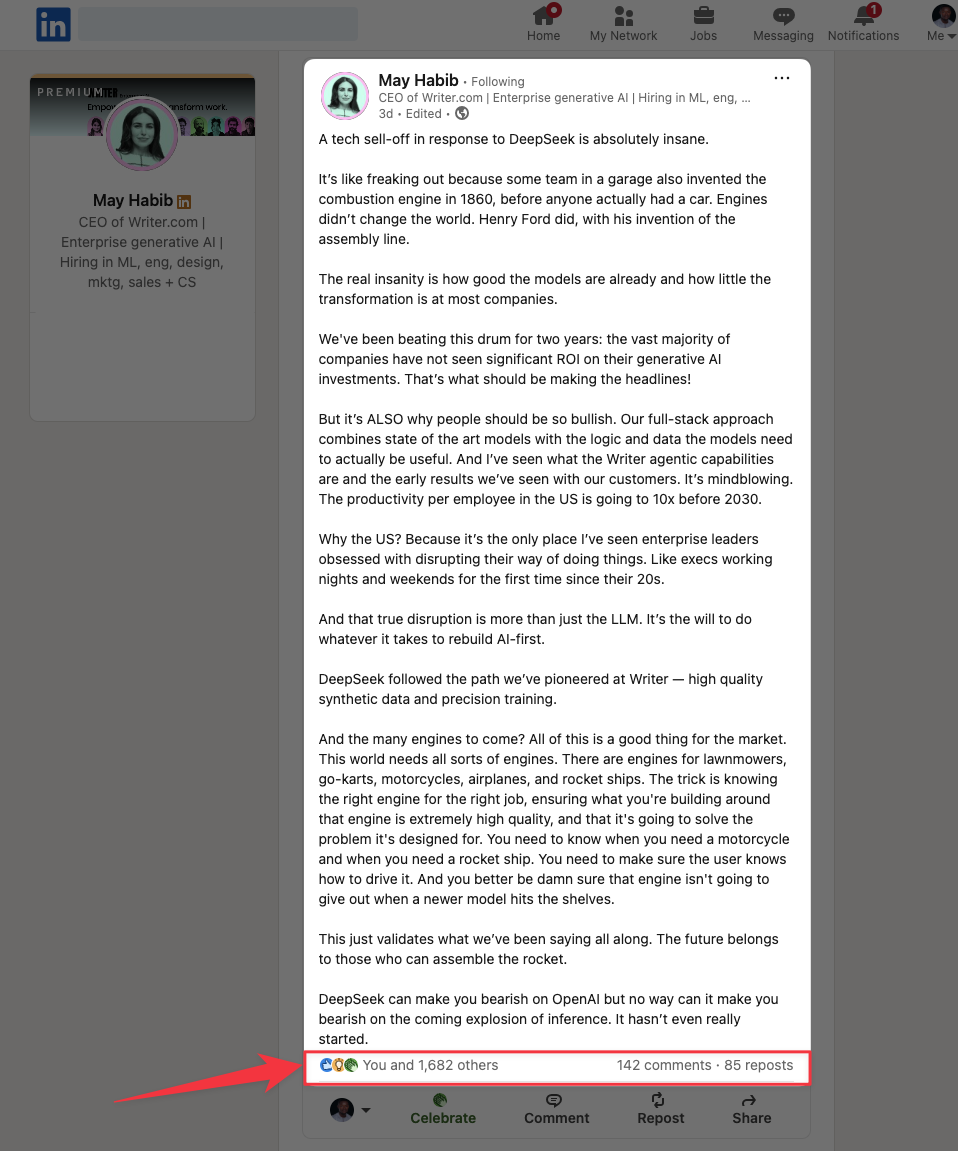
Take a moment to read the post.
…
..
.
Done?
Good.
Did you notice May Habib, CEO of Writer, didn’t just add her take to the DeepSeek debate? Instead, she reframed the conversation, challenging her followers to look at it differently. Even more impressive, she tied her argument directly to Writer’s unique value proposition, making her perspective a subtle brand awareness play.
Stumbling upon her viral post scratched an itch I’d been rigorously observing for months: how some B2B SaaS Founders and Executives don’t just participate in the thought leadership content game—they dominate it in ways others can only dream of.
Among the standout Founders I’ve been stalking are May Habib (Writer), Wes Kao (Maven), Rand Fishkin (Sparktoro), and Adam Robinson (Retention; RB2B). For Marketing Executives, Amanda Natividad (Sparktoro), Kieran Flanagan (HubSpot), and Tim Suolo (Ahrefs) consistently rise above the noise.
What makes them different? Why does most of what they share resonate so powerfully, leading to enviable engagement?
Four defining traits emerged from my observations:
- Skin in the game: They deeply understand their industry, product, and target audience.
- Unique perspectives: Their viewpoints amplify their brand narrative and highlight their product’s distinctive value.
- Mind-shifting antithesis: They challenge prevailing wisdom and shape trending market perspectives.
- Compelling prose composers: They masterfully blend storytelling and copywriting to articulate their thoughts, leading to massive engagement and brand awareness.
Below, I unpack these traits with insights you can leverage to create business-driving B2B thought leadership content.
1. Skin in the Game
Think of this as a new chef who is eager to satisfy customers’ taste buds or one who has spent years mastering their craft. They don’t just read cookbooks; they experiment, fail, refine, and ultimately create signature dishes that stand out.
Likewise, exceptional thought leaders don’t just skim the surface; they live and breathe their domain. They’re in the grind daily or have spent years refining their expertise and have firsthand experience with the pain points their audience faces.
As such, when they share thoughts on anything, they subtly hint at a solution to customers’ pains. This is what makes their thoughts become leading ones for their target market (and their brands).
Take May Habid, Founder & CEO of Writer.
She doesn’t just talk about AI tools. She’s always skewing it to insights on enterprise adoption and integration of generative AI in their workflows, which is often a subtle pitch for Writer.
Case in point, these LinkedIn posts:
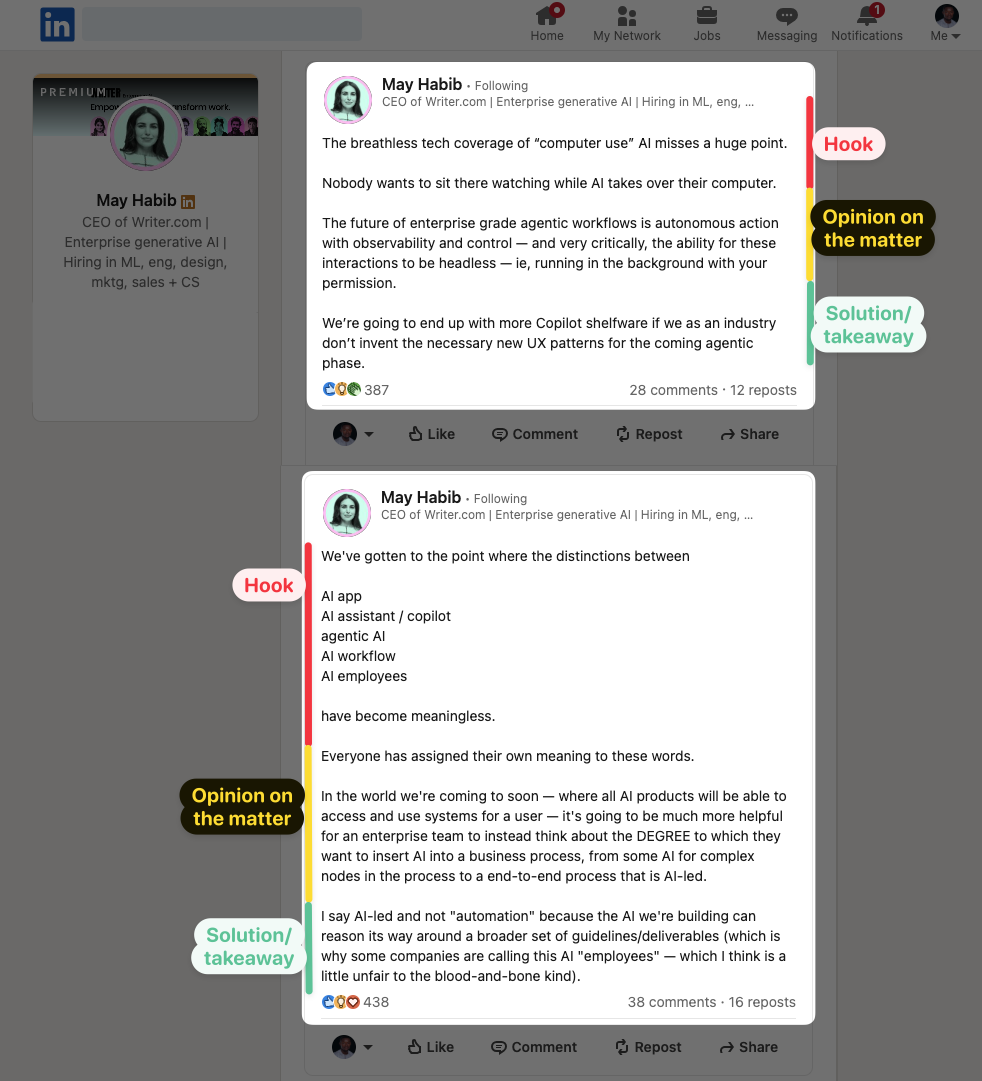
Observe the content of the posts above closely—as I’ve done for many months—and you’ll see a pattern. Habib often starts with a hook. She’d then share her opinion on a matter/trend and close with insight or takeaway that makes you want to check out the solution they’re building at Writer.
The same goes for Rand Fishkin, a co-founder of Moz before launching Sparktoro. Rand spent decades dissecting SEO and is now doing the same with audience intelligence.
As a result, his perspectives are razor-sharp because he hasn’t just been in the trenches, analyzing search engine behavior. He’s still in the trenches. Only this time, he’s analyzing audience data and sharing insights leading and shaping the conversation for the market and his target audience (myself included).
Rand leans more on videos.
But the pattern is similar to Habib’s:
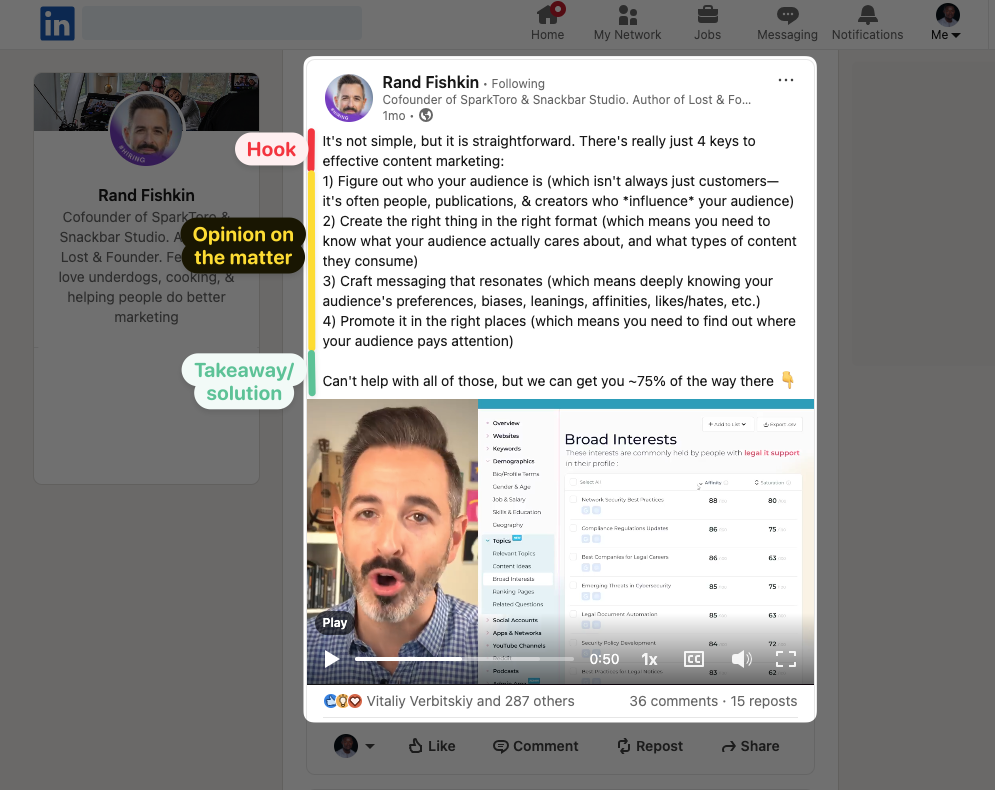
The lesson here?
Thought leaders do before teaching. Or teach what they’re seeing from what they’re doing. They have skin in the game. They’re in the trenches. As a result, their content feels authentic because they are practitioners, not just surface-level or armchair commentators.
2. Unique Perspectives
Imagine a filmmaker who tells a story in a way no one else can. The plot might be familiar, but the way they frame it, the angles they use, and the emotion they inject make it uniquely theirs.
Those I’ve observed to be doing exceptional thought leadership content are like such rare filmmakers. You see, anyone can rehash industry trends or talk about them without adding any meaningful insights. Not the Founders and Executives I’ve been observing.
They always inject their unique lens into every discussion. But most importantly, they position their insights to align with their brand’s vision and their product’s differentiating value.
Wes Kao, Co-Founder of Maven, embodies this.
She champions the idea of “spiky” content—perspectives that aren’t universally agreeable but spark meaningful conversations. Kao approaches executive communications and influence with such “spiky” perspectives only she can frame:
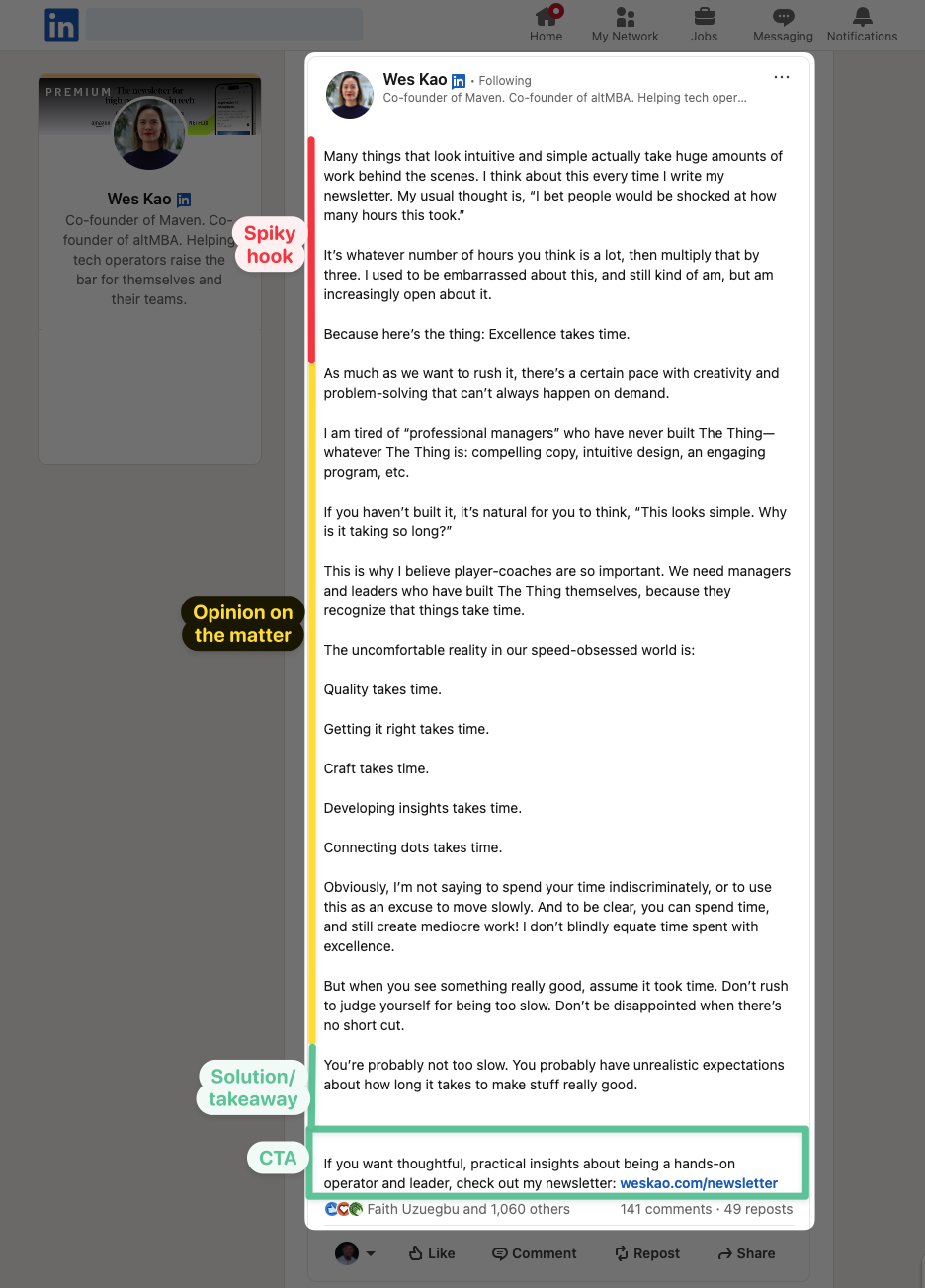
On the surface, it may seem like Wes is just being generous with sharing her thoughts. Well, she is—I learn a lot from her free, spiky thoughts. But looking deeper, there’s more at play.
This approach directly aligns with Maven’s mission of expert-led, cohort-based learning, where dialogue and debate drive growth. In other words, she does Product-Led Storytelling in plain sight.
That’s why the unique perspectives she shares compel people to join her newsletter, from where she sells her course:
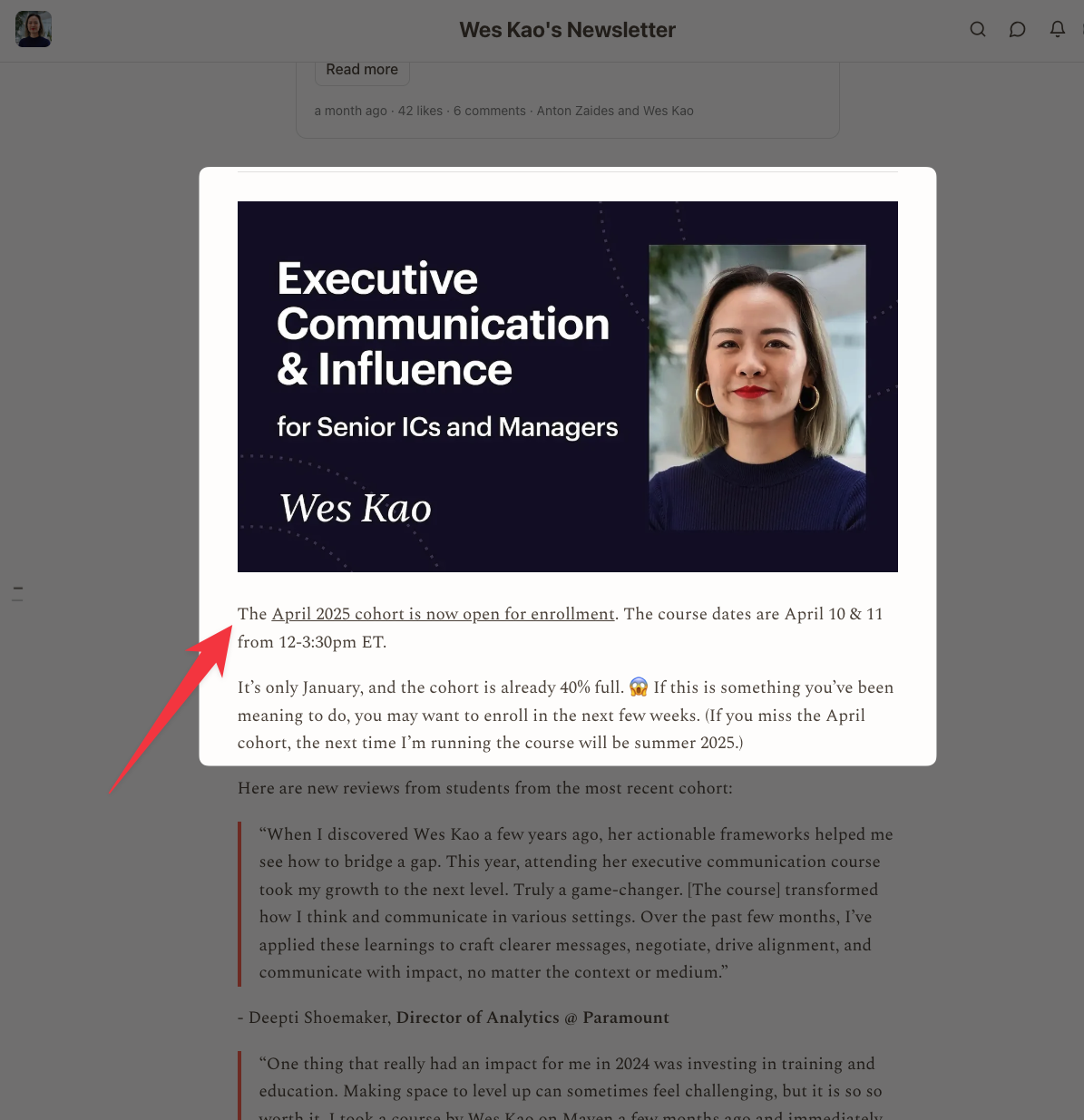
And where the cohort-based course is hosted?
You guessed it right.
Her cohort-based course SaaS startup, Maven:
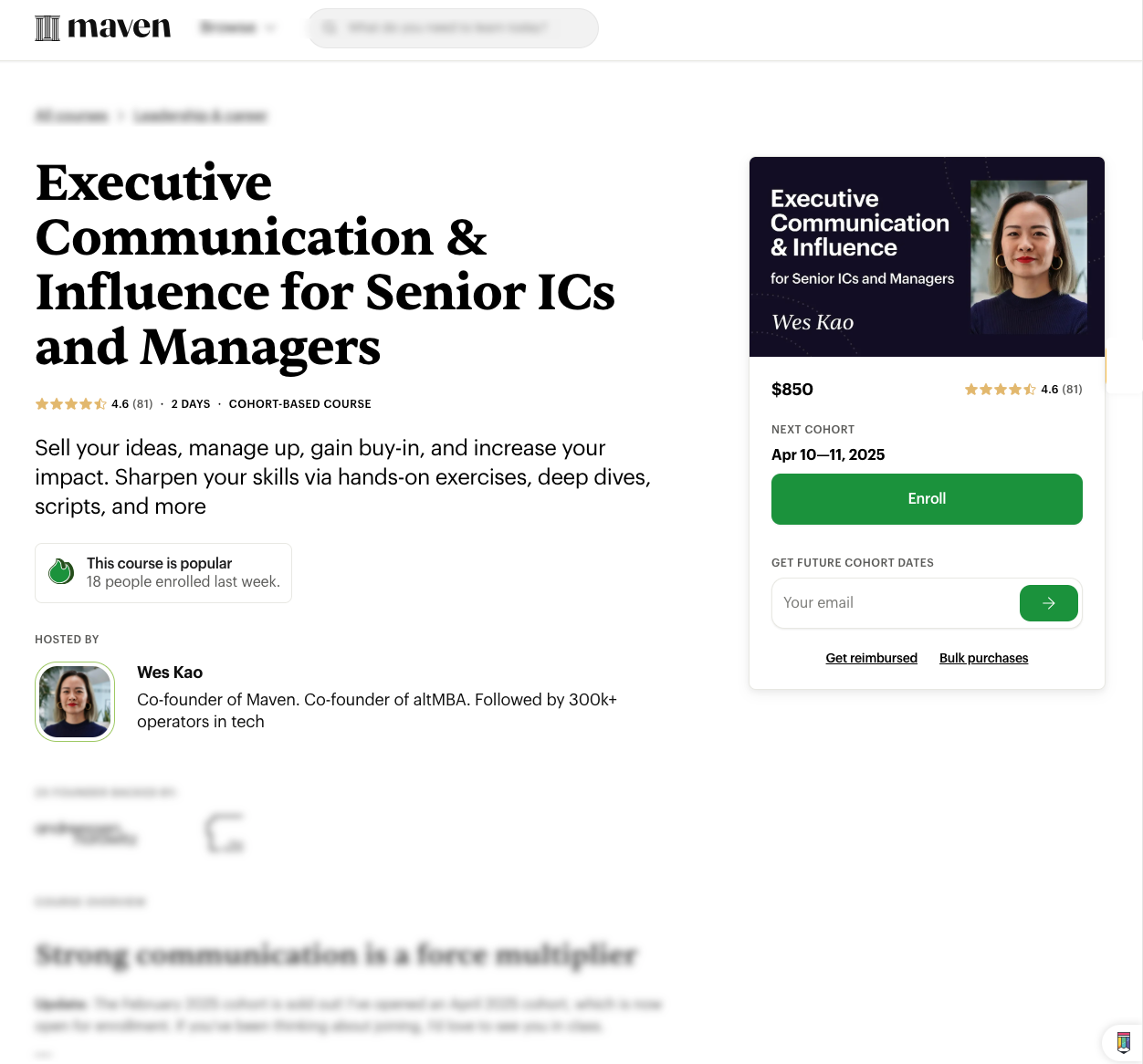
Tim Suolo, CMO at Ahrefs, is another example.
Tim consistently ties his thoughts on marketing execution to Ahrefs’s stance on creating product-led content. That is content targeting keywords with high business potential and organic search engine discoverability. This makes his thoughts not just generous leading thoughts, but ones subtly selling the Ahrefs product.
Take this post:

The lesson?
Own perspectives that strengthen your brand’s narrative and make your product seem indispensable. This ensures that when creating each thought leadership piece, you can frame it to beam a spotlight on your product’s unique value or offer.
You gotta pay the bills, after all.
3. Mind-Shifting Antithesis
Each known norm has an established thesis.
As such, they often become boring—ignored and stagnant—until challenged by a mind-shifting antithesis:
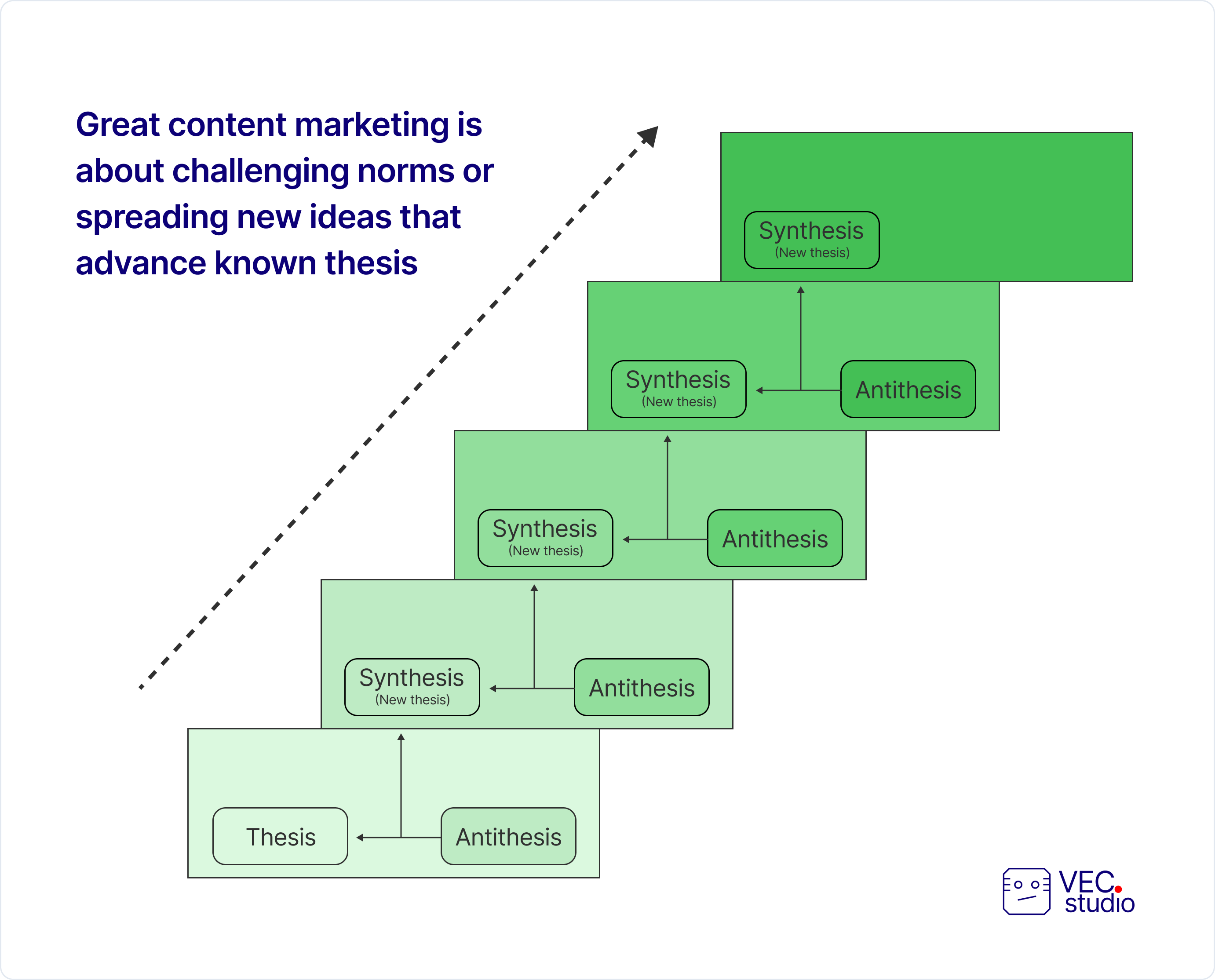
Think of a grandmaster chess player who doesn’t just follow conventional openings but introduces unexpected moves that force the opponent to rethink their entire strategy.
Likewise, thought leaders I’ve observed don’t blindly follow trends. They dissect them, question them, and introduce new ways of thinking. Armed with the previous two traits—skin in the game and unique perspectives—discussed, the mind-shifting antithesis they preach breaks through the noise and guide audiences toward more nuanced insights.
Adam Robinson, CEO of Retention & RB2B, comes to mind.
In an era where cookie-based B2B marketing is on the decline, he challenges the notion that brands should give up on outbound strategies. Instead, he preaches a new method—inbound-led outbound (which his product, RB2B, enables)—for ethically leveraging intent data, yielding a synthesis different from the known outbound thesis:
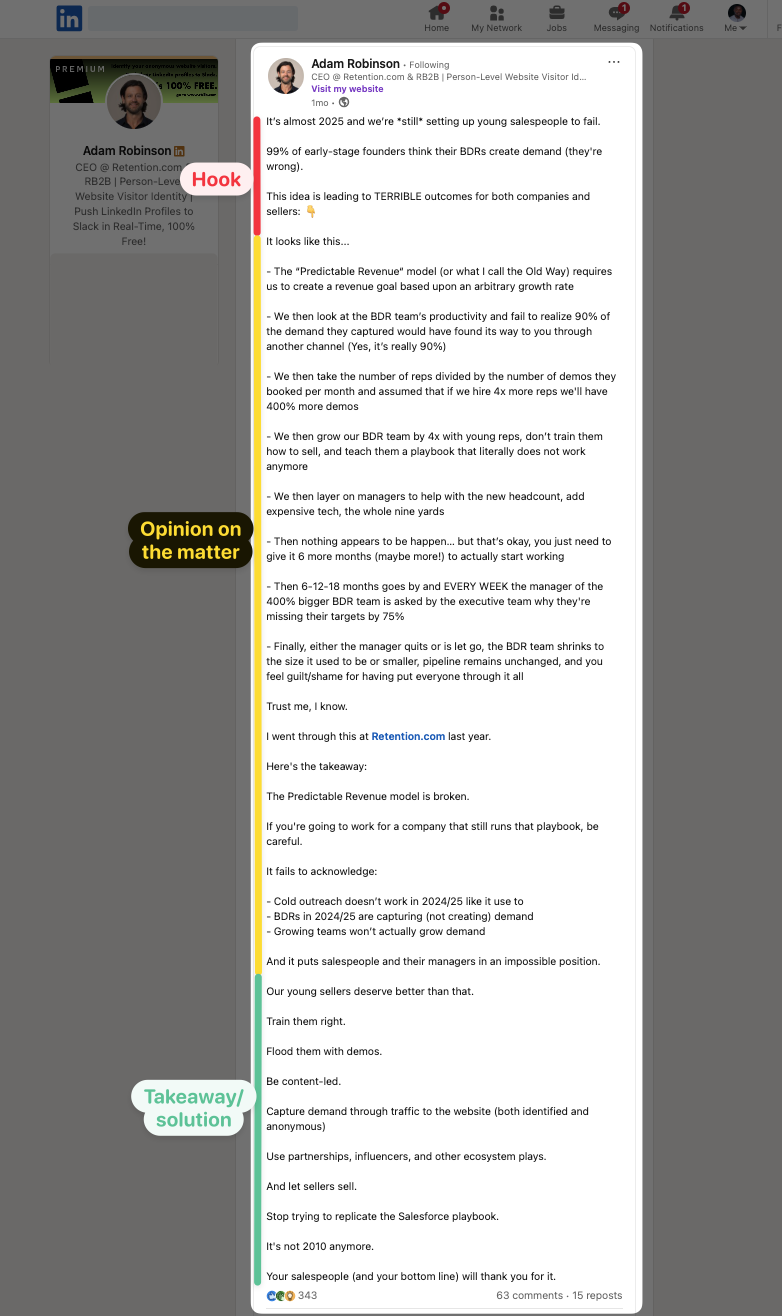
Kieran Flanagan, CMO at HubSpot, does the same.
Kieran consistently ties his thoughts to how HubSpot’s Inbound Marketing positioning is adjusting to the current realities of B2B marketing strategy. His viral LinkedIn posts on such matters aren’t just informative; they subtly reinforce HubSpot’s core principles and showcase their product’s evolving strengths.
Take this one:
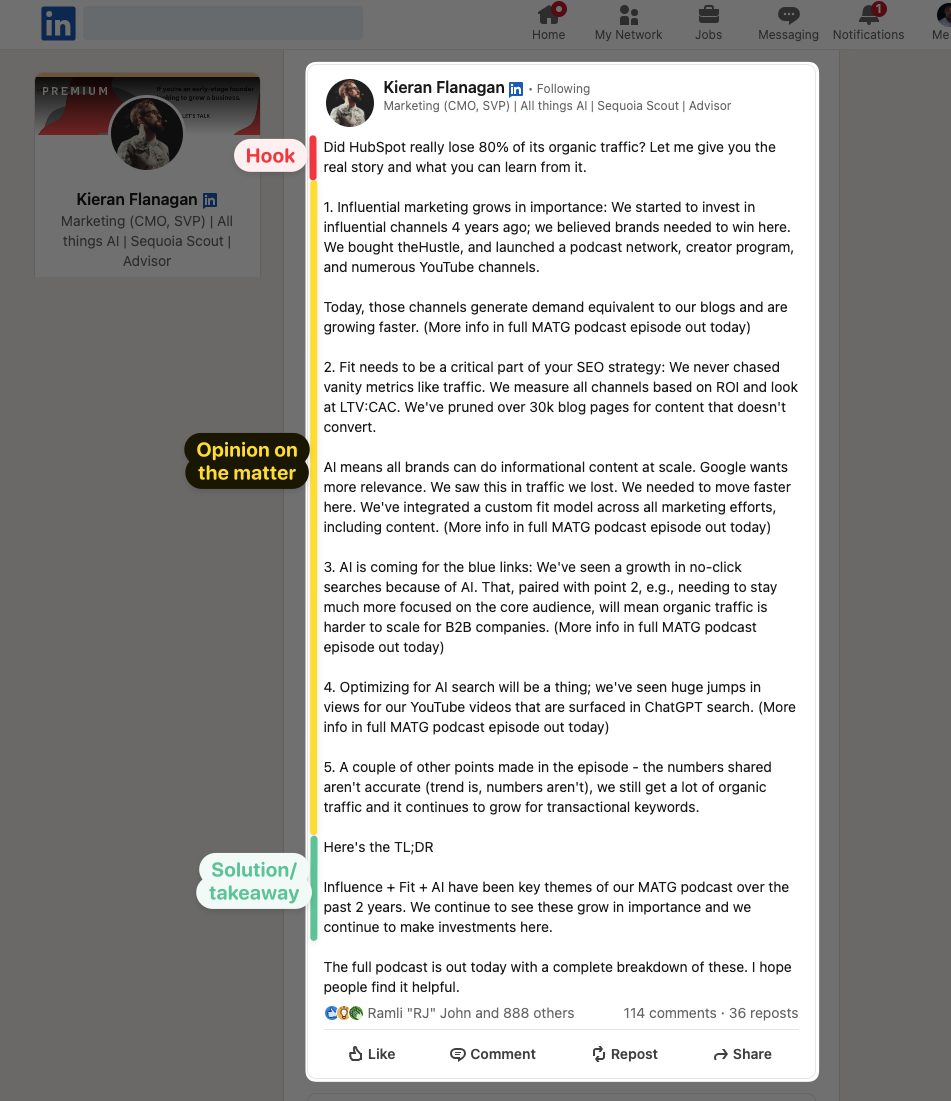
The lesson here is straightforward.
Offer a compelling antithesis to common industry beliefs. Do this well, and you’ll create thought-leading intellectual tension that keeps your audience engaged and your brand top of mind.
But to do that comes my final observation…
4. Compelling Prose Composers
Great thoughts lead to great thought leadership content. But having great thoughts alone doesn’t cut it—how you articulate them in writing determines if you’ll create any impact.
As you would’ve noticed, the thought leaders I’ve studied all have an exceptional ability to communicate with clarity, brevity, and emotion. Like bestselling novelists who know how to captivate an audience from the first sentence, the words used to construct their content aren’t just functional; they evoke emotions, create mental pictures, and make complex ideas digestible.
Amanda Natividad, VP of Marketing at Sparktoro, is a master of this. Her Twitter threads, blog articles, and LinkedIn posts distill complex marketing concepts into digestible, engaging narratives. Her style—like other thought leaders I’ve observed for long— is essentially a blend of storytelling and copywriting.
And the result?
Compelling prose composed to achieve what she calls Zero-Click Content. This means content that actually gets read—without a need to click—on the channel you post the content.
Here’s proof that Amanda does this well:
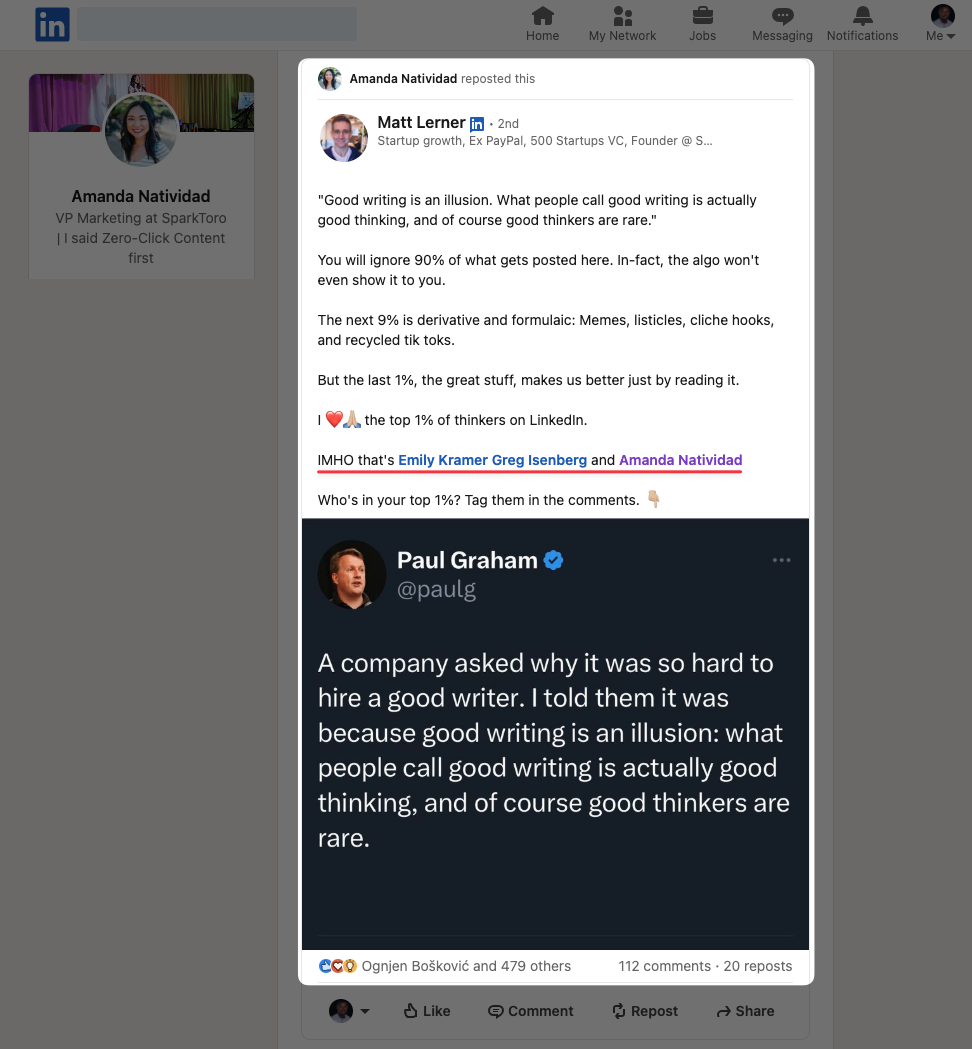
Citing Paul Graham’s quote, Matt Lener, a thought leader himself, noted how difficult finding good business writers has become. He, however, named Amanda as one of the top 1% of such rare writers.
But what is good writing in our context?
It’s really the ability to compose prose that compels people to stop scrolling and read. You won’t score the level of engagement that leads to prospects seeing you as a thought leader in your niche if they don’t read the content you create.
That’s why the ability to structure thoughts in a way that hooks the reader is worthy of being studied. And why I’ve been studying and continue to study all the thought leaders mentioned in this article.
You should do the same.
Whether it’s through sharp one-liners or relatable scenarios, it’s their writing that makes their ideas stick. Blending storytelling with copywriting, they write with clarity and conviction.
This is what separates thought leaders from thought participants. Strong writing makes their message resonate and stick long after audiences have finished reading, earning buyers’ mindshare:
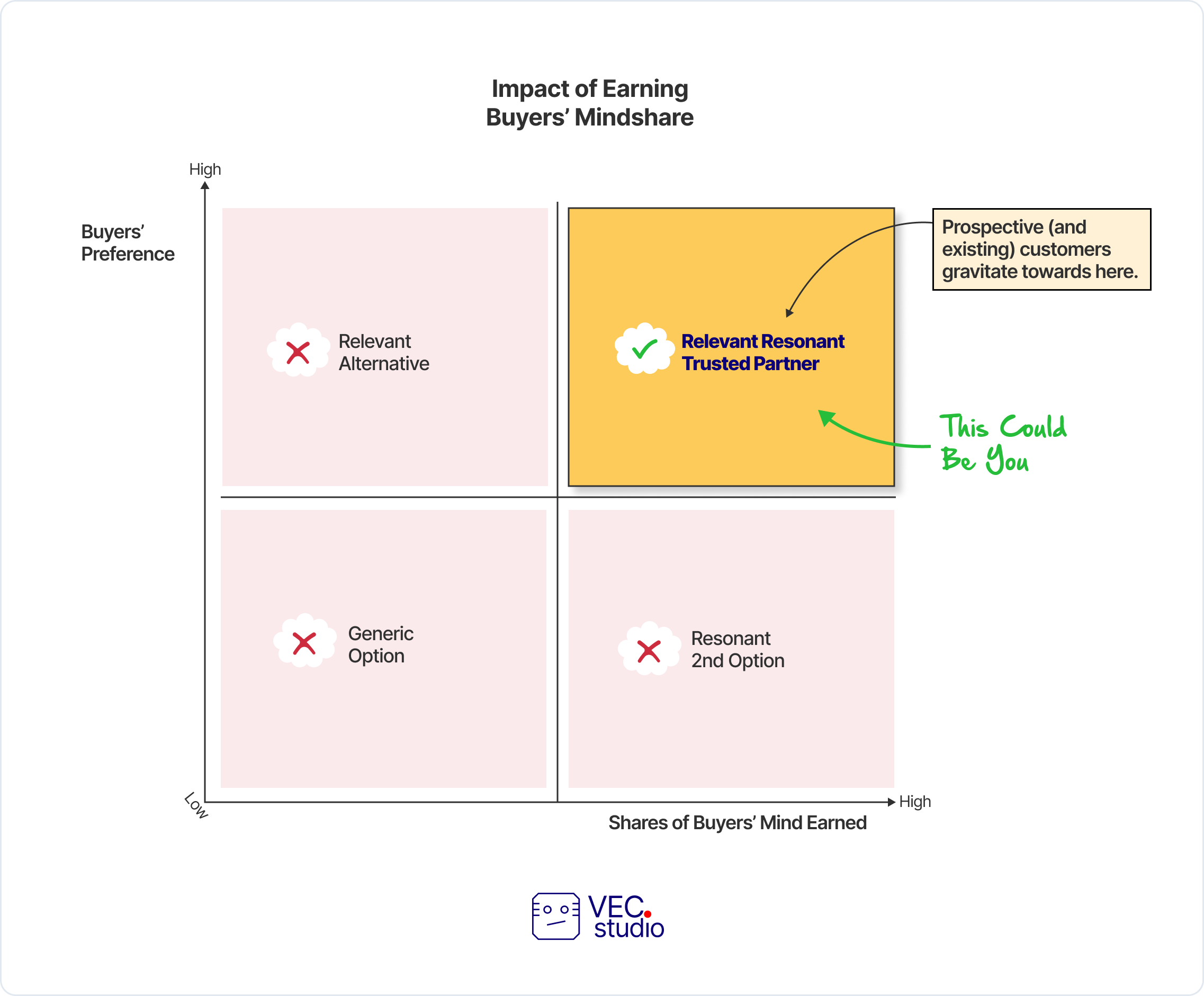
To achieve this…
Strategize & Prioritize Ideas
If you’re a B2B SaaS Founder aiming to scale beyond $10M ARR, the thought leadership game isn’t optional—it’s essential. So take a page from the highlighted founders and executives and set sail.
To sail smoothly, nail these four traits:
- Know your space inside out: Be a practitioner, not just an observer.
- Develop distinct perspectives: Tie your insights to your brand and product.
- Challenge conventional wisdom: Reframe trends and introduce new ways of thinking.
- Master the art of compelling writing: Clarity and brevity win attention.
But if you’re still finding your footing in thought leadership, start with the basics. Design a ‘product-led’ content marketing strategy. Then go into the trenches by talking to customers to grasp their pain points while keeping a pulse on evolving market trends.
As you do that, collect, evaluate, prioritize, and choose content ideas that have the potential to shape industry conversations while bringing a spotlight to your product’s unique value.
To streamline this, try my Ideas’ Business Value Score Template—a framework designed to help you systematically collect, evaluate, score, and prioritize ideas with high business potential. The right ideas, framed the right way, can position you as a leading voice in your industry, attracting target buyers.
Start today.

Victor Eduoh
Founder, VEC Studio
Founder, Lead Strategist @VEC. Thinker, reader, and wordsmith. Before all that, though, I am Omosede’s husband. And besides crafting product-led stories, I love grooming rare writing talent into worldclass product storytellers. That you?
Crafted with ❤️ in Port Harcourt